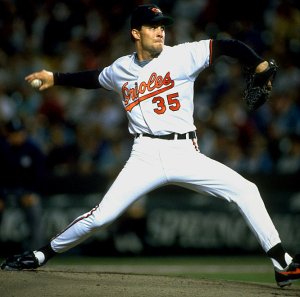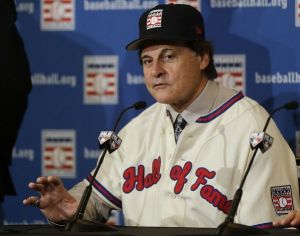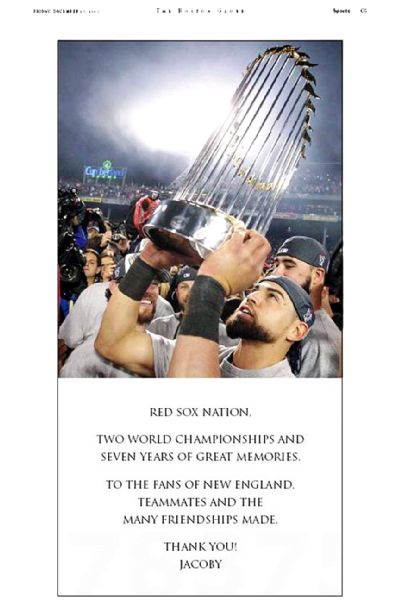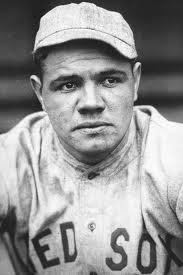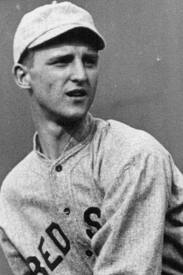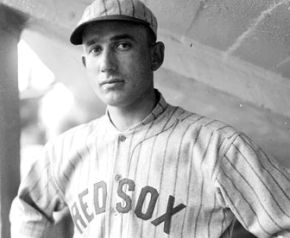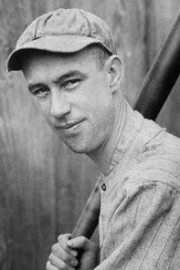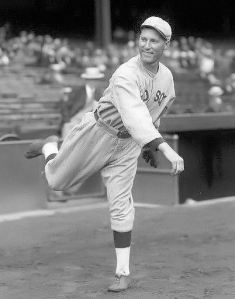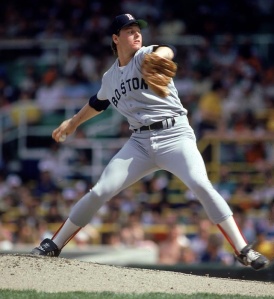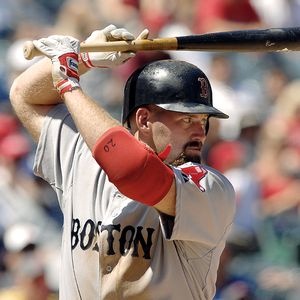Tagged: Roger Clemens
David Price and the best uniform numbers ever
From ESPN Boston: David Schoenfield, ESPN Senior Writer
David Price was officially introduced as a member of the Boston Red Sox on Friday. Price has worn No. 14 throughout his career — with Tampa Bay, with Detroit and with Toronto — but that number is retired in Boston in honor of Hall of Famer so Jim Rice so he chose No. 24.
That’s a pretty storied number in Red Sox history. Dwight Evans — a better player than Rice but not in the Hall of Fame — wore it from 1973 to 1990 and he’s one of the most popular players in Red Sox history. But the Red Sox only retire the numbers of Hall of Famers, so five players have worn it since Evans. One of those was Manny Ramirez, who wore it from 2001 to 2008.
That got me to thinking: What’s the greatest jersey number for one team? By that, I mean worn by more than one great player. Here are some nominees:
- Boston Red Sox No. 24: Dwight Evans, Manny Ramirez, David Price. Total WAR: 99.4 and counting. (That WAR is only for the players listed and only while with the Red Sox; many others have worn the number, but I’m looking at major stars only. Good luck if you want to invest the time for all players.)
- New York Yankees No. 8: Bill Dickey and Yogi Berra. Two Hall of Fame catchers, the number is now retired. Total WAR: 112.3.
- New York Yankees No. 9: Roger Maris, Graig Nettles, Hank Bauer, Charlie Keller and Joe DiMaggio. The number is retired in Maris’ honor, although Nettles, Keller and Bauer each accumulated more WAR while with the Yankees. DiMaggio wore No. 9 as a rookie before shifting to No. 5. Total WAR: 145.6 (using just the one season for DiMaggio). Might be hard to beat that total.
- Chicago Cubs No. 31: Fergie Jenkins and Greg Maddux. Two Hall of Fame right-handers, the number is now retired in honor of both. Total WAR: 87.1.
- Seattle Mariners No. 51: Randy Johnson and Ichiro Suzuki. Who gets ultimate retirement honors? I’m guessing the Mariners will retire it in honor of both once Ichiro makes the Hall of Fame. Total WAR: 96.1.
- Detroit Tigers No. 3: Alan Trammell, Dick McAuliffe, Ian Kinsler, Mickey Cochrane (1934-1937), Charlie Gehringer (1931). This is interesting since two Hall of Famers wore it for a short period plus Trammell, who should be in the Hall of Fame, and McAuliffe, a three-time All-Star. Total WAR: 132.8.
- Pittsburgh Pirates No. 21: Arky Vaughan and Roberto Clemente. Total WAR: 147.8. Vaughan is a Hall of Famer, one of the most underrated players of the 1930s. He wore No. 21 with the Pirates from 1932-1939 and then changed to No. 3 and then No. 5 for some reason. I included only his 1932-1939 WAR but that was enough to push this duo above the Yankees’ No. 9 guys.
- San Francisco Giants No. 25: Bobby Bonds and Barry Bonds. Total WAR: 150.3. Barry accounts for 112.3 of that. Not included: Dan Gladden. But if you throw in 19.3 WAR from Whitey Lockman you’re up to 169.6.
- Los Angeles Dodgers No. 6: Carl Furillo, Ron Fairly and Steve Garvey. No Hall of Famers, but three good players. Garvey’s number is retired, oddly enough, by the Padres but not the Dodgers. Total WAR: 84.5.
- New York Yankees No. 15: Red Ruffing, Tommy Henrich (1946-1950), Tom Tresh, Thurman Munson. The number is retired for Munson, although Ruffing is in the Hall of Fame. Total WAR: 125.5.
- Los Angeles Angels No. 27: Vladimir Guerrero and Mike Trout. Vlad played with the Angels for only six seasons, but he did win an MVP award wearing No. 27. Hmm, how many teams have had two different players win an MVP award wearing the same number? Total WAR: 60.7 and counting.
By this measure, Bonds and Bonds is enough to make the Giants’ No. 25 the best number ever. Did I miss any other candidates? You can go to Baseball-Reference.com to check out the number history for each franchise.
____________________________________________
Okay, I’ll buy some of this, makes for great social media-war type stuff, but I think under these conditions, it’s just too simple and doesn’t really get into the actual subject matter of “Best Number”. Sure, it’s about the number and not the actual players who wore them outside of their WAR, I can see that, but being a bit more traditionalist… eh. How much of the actual Barry Bonds numbers can you, PED use aside, factor into the #25
argument? As the Riddler once said, “Too many questions…”
24 is actually one of my fave Red Sox numbers, mainly for Dewey and
having grown up watching him until his final year in Baltimore (yes, Dwight Evans played a year for the Orioles). I was heartbroken when Manny wore it, simply because it was Dewey’s and it should have been Dewey’s… ’nuff said. Yes other players had worn it between them and since, but again, I don’t really look at Kevin Mitchell’s short stint patrolling the famous Fenway RF in #24 as anything dramatic, nor anyone else’s stints.
But added up WAR aside… how do you get past 9? Sure that’s based on the player who wore it but still… Teddy Ballgame as a singular baseball individual, never mind war hero (as well as WAR hero in stats terms) and American Icon (yes, he was a foul-mouthed bastard but his legacy goes well beyond that, Thank You) who still overshadows the combined three individuals mentioned in the above article. And yes, Dwight Evans is HOF worthy, just was never the ‘Superstar’ of the team as he played with Yaz, Fisk, Rice, Boggs (all HOF) and the likes of Roger Clemens, Fred Lynn, Tony Pena and other lightning rods for the press. He never had a long collection of league-leading years but trended upwards during the latter half of that career. That however, is an argument that has been made and shall be made again…

Oh, NOTE: Yes, the Red Sox have made it policy that retired numbers are an honor for players who played 10 years in the uniform, retired with the team and made the HOF… except Johnny Pesky, whose 4.2 billion years of service to the organization merited his #6 be retired.

I’ve made a case for the Red Sox to implement an ‘Honored’ number selection, where specific player’s numbers are posted with their names in road jersey style upon the center field interior of the bleachers wall, keeping that number in uniform rotation but still paying homage to the player. Example: 21 Clemens in Navy Blue numbers/letters (or Red depending on the away jersey style you prefer… I liked the original non-name roadies and the 2009 to 2013 version), 26 Boggs or 24 Evans, etc., This keeps the number in rotation (though 21 may never be worn either way… as it should be, all the PED rhetoric aside, Rocket’s Sox years were his prime HOF years) but still gives the deserved recognition to those who wore it before. The Toronto Maple Leafs have had such a system in place for years.
Just my humble opinion.
p.s. If the continuing embargo versus career DH’s in the HOF, where will this leave Big Papi in the retired number conversation??
It’s a New Year! Maybe it’s time to elect some starting pitchers to Cooperstown?
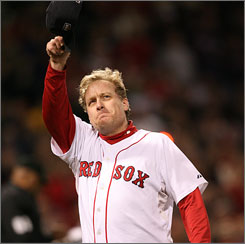 Curt Schilling appeared on the Hall of Fame ballot for the first time a year ago with overwhelmingly strong credentials for election: The 216-game winner ranks 26th all-time in wins above replacement for pitchers (17th-highest total since the live ball era began in 1920) and 15th all-time in strikeouts, including three 300-strikeout seasons; he’s got the best strikeout-to-walk ratio of any pitcher ever (well, not counting a guy named Tommy Bond who was 5-foot-7, born in Ireland and began his career with the 1874 Brooklyn Atlantics) and three 20-win seasons; and he led the league twice in wins, twice in innings, three times in starts, four times in complete games (his 15 complete games in 1998 is the highest total in the majors since 1991), twice in strikeouts and five times in strikeout-walk ratio. Schilling never won a Cy Young Award but finished second in the voting three times.
Curt Schilling appeared on the Hall of Fame ballot for the first time a year ago with overwhelmingly strong credentials for election: The 216-game winner ranks 26th all-time in wins above replacement for pitchers (17th-highest total since the live ball era began in 1920) and 15th all-time in strikeouts, including three 300-strikeout seasons; he’s got the best strikeout-to-walk ratio of any pitcher ever (well, not counting a guy named Tommy Bond who was 5-foot-7, born in Ireland and began his career with the 1874 Brooklyn Atlantics) and three 20-win seasons; and he led the league twice in wins, twice in innings, three times in starts, four times in complete games (his 15 complete games in 1998 is the highest total in the majors since 1991), twice in strikeouts and five times in strikeout-walk ratio. Schilling never won a Cy Young Award but finished second in the voting three times.
Of course, Schilling was also one of the greatest postseason pitchers ever, going 11-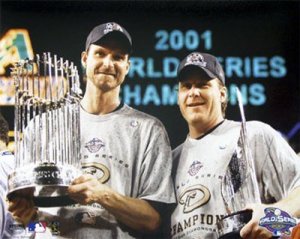 2 with a 2.23 ERA in 19 starts. His October legacy includes his iconic Bloody Sock Game in Game 6 of the 2004 American League Championship Series against the Yankees, a win in the World Series that year that helped end the long suffering of Red Sox fans, plus his dominant performance throughout the 2001 postseason when he allowed six runs in six starts as the Diamondbacks won the World Series. He helped the Red Sox win another title in 2007. His career 3.46 ERA in a hitters’ era gives him an adjusted ERA equal to Tom Seaver and Bob Gibson and higher than Hall of Famers like Jim Palmer, Juan Marichal and Bob Feller.
2 with a 2.23 ERA in 19 starts. His October legacy includes his iconic Bloody Sock Game in Game 6 of the 2004 American League Championship Series against the Yankees, a win in the World Series that year that helped end the long suffering of Red Sox fans, plus his dominant performance throughout the 2001 postseason when he allowed six runs in six starts as the Diamondbacks won the World Series. He helped the Red Sox win another title in 2007. His career 3.46 ERA in a hitters’ era gives him an adjusted ERA equal to Tom Seaver and Bob Gibson and higher than Hall of Famers like Jim Palmer, Juan Marichal and Bob Feller.
Schilling was great, he has the advanced metrics that scream Hall of Famer, and he was an iconic figure in the game while active. What more do you need to get elected to Cooperstown?
More than 60 percent of voters didn’t check Schilling’s name on their ballot.
Then there’s the pitcher who finished with the same career adjusted ERA as Schilling. His best ERAs, all in seasons where he pitched more than 210 innings, were 1.89, 2.38, 2.39, 2.58 and 2.69, all coming when offensive totals were exploding. The worst of those seasons had an adjusted ERA+ of 150. Since 1920, only five other starters had five or more seasons with at least 200 innings and an ERA+ of 150 or higher: Greg Maddux, Roger Clemens, Lefty Grove, Randy Johnson and Roy Halladay. This pitcher had another season where he went 18-9 with a 3.00 ERA and another where he went 21-11 with a 3.32 ERA while leading his league in innings pitched. He won more than 200 games. He had a 16-strikeout game in the postseason. His career pitching WAR of 68.5 is higher than Palmer, Carl Hubbell or Don Drysdale.
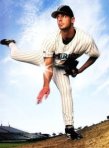 Kevin Brown got 12 votes in his one year on the ballot, not close to the 5 percent needed to remain on the ballot, and he was kicked to the curb alongside Raul Mondesi, Bobby Higginson and Lenny Harris. Thank you for your nice career, but your case has no merit. Heck, Willie McGee received twice as many votes. I mean, Willie McGee was a nice player, and even a great one the season he won the MVP Award, but he had about half the career value of Brown.
Kevin Brown got 12 votes in his one year on the ballot, not close to the 5 percent needed to remain on the ballot, and he was kicked to the curb alongside Raul Mondesi, Bobby Higginson and Lenny Harris. Thank you for your nice career, but your case has no merit. Heck, Willie McGee received twice as many votes. I mean, Willie McGee was a nice player, and even a great one the season he won the MVP Award, but he had about half the career value of Brown.
The Baseball Writers’ Association of America treats starting pitchers like they’re infected with the plague. They’ve elected one in the past 14 years: Bert Blyleven in 2011. And Blyleven, despite winning 287 games and ranking 11th all-time in WAR among pitchers, took 14 years to finally get in. Meanwhile, the BBWAA has elected three relief pitchers in those 14 years, so it’s not an anti-pitcher bias; it’s an anti-starting pitcher bias.
What’s happened here? How come no starting pitcher who began his career after 1970 is in the Hall of Fame? Leaving aside the case of Clemens, who would have been elected if not for his ties to PEDs, there are several issues going on.
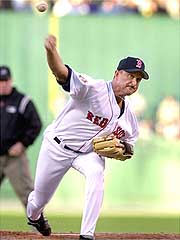
1. The 1980s were barren of strong, obvious Hall of Fame pitchers. The BBWAA ignored the cases of borderline candidates like David Cone (pictured below), Dave Stieb, Bret Saberhagen (pictured above) and Orel Hershiser, and instead embraced Jack Morris, a lesser pitcher than those four but a guy with more career wins.
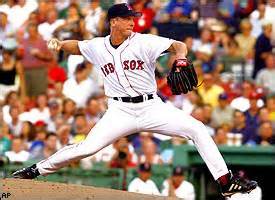
2. Comparison to the previous generation of starters. Including Blyleven, there are 10 “1970s pitchers” in the Hall of Fame. Here they are, listed in order of election year along with each pitcher’s 10-year peak period:
Bert Blyleven (2011): 1971-1980 Nolan Ryan (1999): 1972-1981 Don Sutton (1998): 1971-1980 Phil Niekro (1997): 1970-1979 Steve Carlton (1994): 1972-1981 Tom Seaver (1992): 1968-1977 Fergie Jenkins (1991): 1967-1976 Gaylord Perry (1991): 1967-1976 Jim Palmer (1990): 1969-1978 Catfish Hunter (1987): 1967-1976
These pitchers aren’t merely just great pitchers but products of their generation. The late ’60s and early ’70s produced the lowest-scoring seasons in the major leagues since the dead ball era. The average team in 1968 scored 3.42 runs per game, the lowest total since 1908. That was the notorious pitchers’ year, but 1972 didn’t see much more offense at 3.69 runs per game. This was also the period when pitchers were worked harder than they had been in decades, making more starts and pitching more innings. The 15-year period from 1963 to 1977 saw 62 different seasons where a pitcher threw 300 innings. The previous 15 seasons saw it happen just 13 times (six by Robin Roberts); the ensuing 15 seasons saw it happen just three times, two of those by knuckleballer Niekro. This period was the perfect time to ferment long careers with lots of wins. More starts and more innings gave pitchers the opportunity to get more wins. It’s no coincidence that the peak seasons of the above pitchers all occurred in roughly the same time span.

3. Speaking of wins … Hall of Fame voters love wins like Yasiel Puig loves driving fast. Morris has 254, a main reason he earned 67.7 percent of the vote last year despite his 3.90 career ERA. Schilling has 216 and Brown 211. The fixation on career wins — and 300 in particular — is the result of a unique generation of pitchers; it’s a standard previous pitchers weren’t held to. Bob Gibson won 251 games, Juan Marichal 243, Whitey Ford 236, Don Drysdale 209 and Sandy Koufax 165. Focus on the entire résumé, not just the win total. Schilling didn’t win 254 games, let alone 300, but he’s a far superior Hall of Fame candidate to Morris.
Let’s compare Tom Glavine to Mike Mussina, both appearing on the ballot for the first time. With 305 wins, Glavine appears to be the much stronger candidate than Mussina, who won 270 games.
Here’s what one voter, Dan Shaughnessy of The Boston Globe, wrote:
Glavine and Maddux were 300-game winners. Those are magic plateaus … unless you cheated.
The rest of the list of players I reject are good old-fashioned baseball arguments. (Craig) Biggio got 68.2 percent of the vote last year, but I don’t think of him as Hall-worthy (only one 200-hit season). Same for Mussina and his 270 wins (he always pitched for good teams) and (Lee) Smith and his 478 saves (saves are overrated and often artificial).
There you go. Glavine won 305 games, Mussina won 270, so Glavine is the easy choice. As an aside: I love the bit about Mussina pitching for good teams. As if Glavine didn’t pitch for good teams? Since when is pitching for good teams considered a demerit?
Plus, as Jason Collette pointed out, “Mussina pitched for Baltimore for 10 years — and Baltimore had losing records in five of those ten seasons. Yet, Mussina had a .645 winning percentage and won 147 of his 270 starts with the Orioles. The Yankees never had a losing record when Mussina pitched there and he had a .631 winning percentage with them. Mussina’s .645 winning percentage as an Oriole dwarfed the team’s .510 winning percentage in that same time.”
(Also, Shaughnessy is apparently voting for Morris because he won 254 games, which I believe is less than 270.)
Anyway, when you examine the numbers a little deeper, Glavine and Mussina compare favorably:
Pitching WAR
- Glavine: 74.0
- Mussina: 82.7
ERA+
- Glavine: 118 (3.54 career ERA in the National League with great defense behind him)
- Mussina: 123 (3.68 career ERA in the American League with often bad defenses behind him)
5+ WAR seasons
- Glavine: 4
- Mussina: 10
Postseason
- Glavine: 14-16, 3.30 ERA, 1.27 WHIP
- Mussina: 7-8, 3.42 ERA, 1.10 WHIP
The point here isn’t to detract from Glavine, but that Mussina has every bit the case Glavine does — or 95 percent of it, giving Glavine some extra credit if you wish for his two Cy Youngs. Glavine hung on and won 35 more games; Mussina retired after winning 20. That doesn’t make Glavine a superior pitcher.
4. Stingy voters. To a certain extent, the BBWAA voters have become tough on all candidates — not just starting pitchers and PED users.
As Joe Sheehan wrote recently:
Consider the recent history of Hall voting. The average number of players named per ballot declined steadily up until just last year. In 1966, which was the first vote in the modern era of BBWAA balloting (that is, in which there have been no years in which the BBWAA did not vote), there were 7.2 names listed per ballot. Ten years later, that figure was 7.6. By 2000, a year that featured two players voted in and a ballot with five others who would eventually be voted in (plus Jack Morris, still kicking around), the number was down to 5.6. There were more baseball players than ever before becoming eligible for the Hall, but the voters were becoming much more difficult to impress. That would remain the case for most of this century:
2001: 6.3 2002: 6.0 2003: 6.6 2004: 6.6 2005: 5.6 2007: 6.6 2008: 5.4 2009: 5.4 2010: 5.7 2011: 6.0 2012: 5.1 2013: 6.6
Remember, that downward trend is occurring despite an increasingly crowded ballot due to the split opinions on what do about the PED candidates. With as many as 15 to 20 legitimate Hall of Fame candidates on this year’s ballot it will be interesting to see if that 6.6 players per ballot increases further.
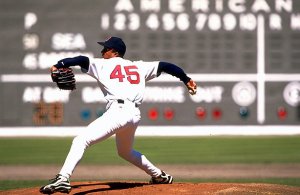
5. Timing. The starting pitching problem will be abated somewhat in upcoming elections. Maddux will get in this year, Glavine this year or next. Randy Johnson, Pedro Martinez (pictured above) and John Smoltz (pictured below) then join the ballot next year. Johnson is a lock, and Martinez has the Koufax-esque peak value thing going for him, although with 219 wins he’s not a first-year lock. Smoltz is similar to Schilling in many ways, down to the career win total (213) and postseason heroics, so odds are he’ll face the same uphill climb.
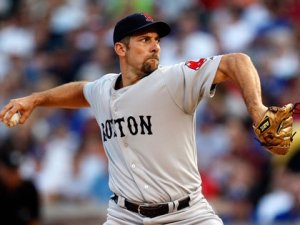
I believe most Hall of Fame voters have the same goal: Elect the best players to the Hall of Fame, or at least the best ones they believe to be clean from PEDs. That issue is still stuck in the mud, the Hall itself refusing to give guidance to the voters. But electing Curt Schilling and Mike Mussina is simply an issue of understanding their greatness. They are among the very best pitchers in the history of the game. They deserve to be elected this year, alongside Maddux and Glavine.
HOF Double Standards? Who’d have thought….
From: Ann Killion of the SFGate
The Baseball Hall of Fame ballots are due at the end of the month and the process just got more confusing than ever.
Steroid players? Still unlikely to be voted in.
Steroid managers? That’s a different story.
The Boys of Steroids are still on the Boys of Summer ballot: Barry Bonds, Roger Clemens, Sammy Sosa, Mark McGwire and Rafael Palmeiro are among the 36 players on the 2014 ballot. They’re all there to be accepted or – more likely – rejected by the majority of the 500-plus Baseball Writers’ Association of America voters who participate (I’m one of those voters).
Last year, none of the players who come with substantial evidence that they used steroids received more than 37.6 percent of the vote. They need 75 percent of the votes to be inducted. Last year not a single player was voted into the Hall of Fame, making for a muted ceremony that probably contributed little to the Cooperstown economy.
Players stay on the ballot for 15 years, so this issue is far from over. However, it takes a lot of mind-changing – and a long time – for a player to jump almost 40 percentage points in balloting.
So all of those players must look at what just happened with the Expansion Era Committee voting last weekend and feel puzzled. Three of the best, most successful managers of the steroid era were elected unanimously: Joe Torre, Bobby Cox and – most notably – Tony La Russa. Easy, quick, no fuss.
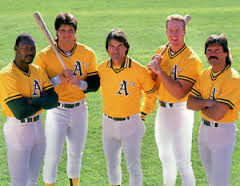 If there were an all-steroid baseball team (Bonds in left, McGwire at first, Clemens on the mound – we can keep going), there’s no doubt who the manager would be. It would be La Russa, who managed the A’s in the late ’80s and early ’90s Bash Brothers era, widely considered Ground Zero for rampant steroid use. Then La Russa went on to manage the St. Louis Cardinals, where McGwire made it fashionable to use steroids to break baseball’s most hallowed records.
If there were an all-steroid baseball team (Bonds in left, McGwire at first, Clemens on the mound – we can keep going), there’s no doubt who the manager would be. It would be La Russa, who managed the A’s in the late ’80s and early ’90s Bash Brothers era, widely considered Ground Zero for rampant steroid use. Then La Russa went on to manage the St. Louis Cardinals, where McGwire made it fashionable to use steroids to break baseball’s most hallowed records.
Along the way to this week’s Hall of Fame vote, La Russa has been a hypocritical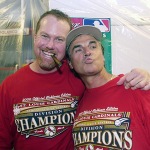 steroid-era bully, pointing fingers at and calling out players he didn’t like, even ones he managed, such as Canseco, while simultaneously angrily defending McGwire and others. He eventually hired McGwire as his hitting coach in a transparent attempt to improve the slugger’s Hall of Fame chances. That backfired: McGwire’s vote tallies actually continue to drop. La Russa has both claimed that everyone knew Canseco was on steroids and to have no knowledge that McGwire was juicing. La Russa has attacked every reporter or outsider who dared to raise the issue.
steroid-era bully, pointing fingers at and calling out players he didn’t like, even ones he managed, such as Canseco, while simultaneously angrily defending McGwire and others. He eventually hired McGwire as his hitting coach in a transparent attempt to improve the slugger’s Hall of Fame chances. That backfired: McGwire’s vote tallies actually continue to drop. La Russa has both claimed that everyone knew Canseco was on steroids and to have no knowledge that McGwire was juicing. La Russa has attacked every reporter or outsider who dared to raise the issue.
But he, along with Torre and Cox, was unanimously elected inside a hotel room in Orlando by 16 voters on the Expansion Era Committee. The Chronicle’s Bruce Jenkins was one of those voters and is sworn to absolute secrecy about the details of the process. But he did describe a closed-door environment where “everyone spoke the same language,” and held old-school values, removed from “the complex lingo of new-age stat devotees.”
I’m sure that the discussion of how the candidates benefited from steroids, if it was raised at all, took a back seat to all the other accomplishments in the candidates’ resumes. The managers elected were certainly helped by the belief that everyone was looking the other way. Of course those same arguments could and have been made on behalf of the steroid-era players on the ballot, and – for now – have been rejected by voters.
So would the steroid-tainted players benefit from getting into that exclusive kind of Expansion Era Committee environment – which they eventually may if they aren’t inducted while on the active ballot? Don’t be so sure. The most vocal opponents of steroid use are the men who have made it into the Hall of Fame. They believe their game and legacy has been tainted (and probably want to keep the Hall of Fame as exclusive as possible). Men such as Frank Robinson, Rod Carew and Andre Dawson who were on this year’s committee all have publicly damned steroid use. A 75 percent threshold would be hard to reach without the former players.
And the committee isn’t likely to embrace the old argument for letting in steroid users, that “you can’t write the history of baseball without them.” After all, they just rejected union leader Marvin Miller, whose contributions are significant to baseball history. Miller, of course, was instrumental in keeping drug testing out of the game for so long.
The process is muddied on so many levels. ESPN commentator Keith Olbermann had an interesting rant about La Russa’s election, noting that Pete Rose is banned from the ballot for betting while managing, which might have caused an unfair and illegal advantage to opponents, while “Tony La Russa was manager of the Founding Fathers of modern PED use who, because of their unfair and illegal advantage, doubtless won games they were not supposed to win.”
Sigh. It’s an honor. It’s a puzzle.
You’re Welcome…..
On the day he will be introduced as the newest New York Yankee, outfielder Jacoby Ellsbury took out a full-page ad in the Boston Globe to thank Red Sox fans for seven years of “great memories.”
Ellsbury, fresh off winning his second World Series ring with the Red Sox, agreed to a $153 million deal with New York last week. The contract includes a $21 million team option for the 2021 season, with a $5 million buyout. If the option is exercised, the deal would be worth $169 million over eight years.
Jacoby will wear No. 22 with the Yankees, (he wore No. 2 with the Red Sox, but obviously that belongs to Yankees captain Derek Jeter) taking over the number of Roger Clemens, another Boston Red Sox star who moved south to New York.
Ellsbury, who turned 30 in September, led the majors with 52 stolen bases despite being hobbled late in the season by a broken right foot. The lefty-hitting leadoff man batted .298 with nine homers and 53 RBIs, and the short right-field porch at Yankee Stadium should boost his power numbers.
He is part of a rebuilding plan by the Yankees, who lost All-Star second baseman to Seattle. New York also agreed to deals with catcher Brian McCann and outfielder Carlos Beltran.
Curse..? Bambino..? What is it you speak of?
Jacoby Ellsbury is just the latest in a long line of Red Sox who have defected (or been shipped to… let’s be fair) to the Bronx.
Yes, Babe Ruth is most famous and spawned the 86 year ‘curse’ that generations of New Englanders swore would (and in many cases did) outlive them. But to be quite serious and objective… The Babe was hardly alone.
Herb Pennock: Somewhat overshadowed by his corpulent teammate (see above), the Hall of Fame lefty went from serviceable starter with the Sawx to an ace for a Bombers ballclub that won its first World Series title in 1923 … and a few more after that.
Sad Sam Jones: Jones, dealt to Boston for Hall of Famer Tris Speaker, won 23 games for the Sox in 1921. So of course that December he was traded to the Yankees. Jones had a bumpy ride in the Bronx, but he did post 21 wins and a no-hitter for the 1923 champs.
Joe Dugan: Boston shipped Jumping Joe to New York midway through the 1922 season, and there he helped the Yanks win their second AL pennant. He’d play in five World Series in pinstripes overall. (The Bombers won three of them.)
Waite Hoyt: In case you thought the ’20s weren’t rough enough for Red Sox fans, this Hall of Fame hurler joined the Yanks in 1921 after two seasons in Boston, averaging 18 wins over the next eight seasons and winning a league-high 22 games for the famed ’27 Bombers.
Red Ruffing: Ruffing lost 20-plus games two years in a row for the Red Sox in 1928 and ’29 — then won 20 or more for the Yankees in four straight seasons, starting in 1936, en route to the Hall of Fame.
Sparky Lyle: Lyle won a Cy Young in 1977 and played on two Yankees title teams. The guys the Bombers traded for him? Danny Cater and Mario Guerrero, who hit a collective .252 in Boston and never played more than 93 games in any of their seasons with the Sox.
Luis Tiant: Unlike the previous players on our list, Tiant joined the Yankees in the twilight of his career, winning 21 games in two seasons in the Bronx (1979 and ’80) after spending several years as the ace of the Red Sox.
Wade Boggs: Boggs put up most of his numbers in Boston, but when it came time for the Hall of Fame third baseman to finally win a title, he did it in the Bronx — famously riding around Yankee Stadium on a horse in 1996.
Roger Clemens: Rocket won three Cy Young Awards in Boston, compared to just one with the Yankees. But two World Series titles (in 1999 and 2000) in the Bronx more than made up for it.
Tom Gordon: Flash became a folk hero in Boston as a starter turned All-Star closer in 1998. He even helped inspire a Stephen King novel, “The Girl Who Loved Tom Gordon.” Did that girl become a Yankees fan when he joined the Bombers’ bullpen six years later?
Doug Mientkiewicz: Eye Chart’s career doesn’t stack up against many of the players on our list, but when the Red Sox finally won a title in 2004, he was the toast of Beantown. The Yanks picked him up in 2007 after he’d had season-long stints with the Mets and Royals.
Johnny Damon: The Caveman tormented the Yanks while a Sox star on the ’04 champs — then crushed Boston fans when he went clean-shaven and signed with the Bombers in 2006. His baserunning heroics in the 2009 World Series won’t soon be forgotten, by either fan base.
Derek Lowe: Lowe was the winning pitcher in Game 7 of the 2004 ALCS, helping the Sox break the Bambino’s curse. After pitching for the Dodgers, Braves and Indians, Lowe signed with the Yankees midway through the 2012 season.
Kevin Youkilis: Youk became a Yank prior to the 2013 season, but a back injury limited The Greek God of Walks to just 28 games (and eight bases on balls, if you’re scoring at home).
Let’s Revisit: #24, RF, Dwight ‘Dewey’ Evans (Re-Post from 1/5/12)
Well, New Year’s usually signals a few things in the baseball universe. The Hot Stove Season is reaching its stretch run. The thought of Spring Trading begins to warm the soul. And perhaps more controversially, The Hall of Fame announcement is upon us.
Every year, we look to the BBWAA to give us a reason to cheer, p!ss and moan or just grit our teeth and throw up our hands with the whole damn process. After all, the guys you love don’t get their recognition, the guys you hate seem to ‘slide’ in and guys you just couldn’t care about grab some spotlight. But we’re used to it.
However, in the last few years, the landscape has changed. The Steroid Era has shed a new light upon players who for lack of ‘super’ stardom, media attention and just plain ‘average’ consistency were overlooked, passed-up or underappreciated for their efforts. Players such as Ron Santo (finally, but posthumously) have received their Veterans Committee due, while players like Keith Hernandez, Dwight Evans, Alan Trammell and Tim Raines have been on the outside looking in. With PED playboys like Big Mac, Sammy Sosa, Palmero and Jeff Bagwell (rightly or not, the shadow covers him) taking up space on the ballot, it let’s periphery guys like Don Mattingly, Dale Murphy, Lee Smith and Jack Morris get a little more time in the thought process over all. Unfortunately, Donnie Baseball and Murphy were superstars who produced consistently but for a shorter span of time (unfortunately, the beloved Luis Tiant may fall into this category) . Smith was a journeyman who, though possessing all the qualities of a big, menacing closer, seems to have been hurt by his many stops around the league and having no definitive ‘superstar moment’. Jack Morris… well, he’s a borderline a Hall of Famer. Yes, he won 20 plus games three times and played on World Series winning teams, catching media spotlight fire with the ’91 Twins & ’92 Jays for example, but he wasn’t the cog that ran the gears. 
Then there’s Edgar Martinez. Easily one of the better hitters of his era (amidst the Steroid Era) who may have more than one glaring mark against him. First, he played in Seattle (yes, so did Griffey Jr., A-Rod and Randy Johnson… but they left), not a media market or a perennial contender. Second, and most importantly, he played the majority of his career as a Designated Hitter. Oh, my error, the Designated Hitter. A standard set so high, the annual award for best DH in the AL is the Edgar Martinez Award. But, DH doesn’t count, it’s an imaginary position created by the Wizard of Oz (you know, a designated spot in the batting order to allow aging, over-the-hill superstars who couldn’t field a position some twilight time to earn a paycheck and pad the HOF stats) and doesn’t deserve consideration. They’re part timers. A pinch-hitter who gets off the bench four or five times a day. Who cares if he produces HOF numbers, right?
So, let’s take a look at one of the most under-appreciated members of the Boston Red Sox: Dwight Evans. (keep in mind these are his totals during his 19 year tenure with the Scarlett Hose. Dewey finished his career with a one year stint in Baltimore.)
- Games played: 2505 Rank: 2nd (1st: Yaz / 3rd Ted)
- Hits: 2373 Rank: 4th (3rd: Rice / 5th Boggs)
- Average: .272 Rank: Outside top 10 ( Yaz .285 / Doerr .288)
- RBI: 1346 Rank: 4th (3rd: Rice / 5th: Doerr)
- HR: 379 Rank: 4th (3rd: Rice / 5th: Ortiz*)
- Runs: 1435 Rank: 3rd (2nd: Ted / 5th: Rice)
- Base on Balls: 1337 Rank: 3rd (2nd: Yaz / 4th: Boggs)
- OPS: .842 Rank: Outside top 10 (Yaz has an .841 / Rice .854)
So, loo king at the numbers, we see obvious questions and answers to the argument. He is, for the most part, sandwiched between teammates who are enshrined in Cooperstown (Captain Carl, Jim Ed., Boggs) and legendary HOF’ers like Ted and Bobby Doerr. The second half of his career was statistically more productive than the first and was consistently so until his retirement. During years when players begin winding down, Dewey was in cruise control and producing at a steady clip.
king at the numbers, we see obvious questions and answers to the argument. He is, for the most part, sandwiched between teammates who are enshrined in Cooperstown (Captain Carl, Jim Ed., Boggs) and legendary HOF’ers like Ted and Bobby Doerr. The second half of his career was statistically more productive than the first and was consistently so until his retirement. During years when players begin winding down, Dewey was in cruise control and producing at a steady clip.
Was he overshadowed? An integral member of the 1975 team, he was a lesser star than Yaz, Tiant, Pudge, Lee and The Goldust Twins. After Lynn and Fisk went West, Tiant let go, Yaz retired and guys like Eck and Lansford come and gone, it was Dewey who came into his own offensively while continuing his defensive excellence. Again, superstars surrounded him. Rice, Hurst, Boggs Buckner and Clemens. Evans simply continued to perform.
During the 1980′s (the latter half of his MLB career which officially began in 1972) in his playing age years of 28 (1980) through age year 37 (1989):
- 3 times finished in the top 10 in the AL in Hits.
- 4 times finished in the top 10 in the AL in Doubles.
- 5 times finished in the top 10 in the AL in RBI.
- 5 times finished in the top 10 in the AL in HR, leading the league in 1981.
- 5 times finished in the top 10 in the AL in OPS% , leading the league twice.
- 6 times finished in the top 10 in the AL in Runs scored, leading the league in 1984.
- 7 times finished in the top 10 in the AL in Bases on Balls, leading the league three times.
Evans appeared on the AL MVP ballot 5 times (all in the 1980’s) with 4 times placing in the top 10. Finished 3rd over-all in 1981 behind winner Rollie Fingers and Ricky Henderson.
8 Gold Gloves. 3 All-Star Games. 2 Silver Sluggers.
His lifetime WAR (wins above replacement) is 61.8 (Mind you, this currently ranks 141st ALL TIME in MLB)
Looking at his basic stats or his Sabermetric stats place him in an above average category. Dwight was included on the BBWAA Hall of Fame ballot in 1997 (5.9%), 1998 (10.4%) and 1999 (3.6%) before dropping off due to insufficient support under the official rules of balloting (under 5% in a given year or reaching 15th year on ballot). His election, like that of Ron Santos’, would be a Veterans committee pick. Currently a member of the Red Sox Hall of Fame, Dwight’s number 24 (originally 40 as a rookie) is still in circulation.

Spotlight: Ellis Burks
One of my fondest Red Sox memories as a kid is actually of my aunt ‘Dibbie’ as it was she who introduced me to and nurtured me through this vast, complex and often bitter-sweet heartbreak we call Red Sox Nation. Cold rainy games in the early ’80’s through bright humid matinees in the ’90’s she’d make an effort to take me to Fenway. Dwight Evans was her favorite player in those days. She originally grew up a Braves fan, riding the elevated train (when Boston’s T had one) with her dad before his early passing and following the exploits of ‘The Kid’ from Beantown’s ‘other’ team before falling in love, as one does, with the Scarlett Hose. It was because of Dibbie that when I attended The Ted Williams Baseball Camp in Lakeville for its final summer as a little kid (my mom scored an awesome gig as camp nurse) I actually knew the legend of ‘Number 9’ and could properly worship him when he arrived. (Being the only child of a staff member there, I ate breakfast with Ted every morning of the several days he spent there.)
nurtured me through this vast, complex and often bitter-sweet heartbreak we call Red Sox Nation. Cold rainy games in the early ’80’s through bright humid matinees in the ’90’s she’d make an effort to take me to Fenway. Dwight Evans was her favorite player in those days. She originally grew up a Braves fan, riding the elevated train (when Boston’s T had one) with her dad before his early passing and following the exploits of ‘The Kid’ from Beantown’s ‘other’ team before falling in love, as one does, with the Scarlett Hose. It was because of Dibbie that when I attended The Ted Williams Baseball Camp in Lakeville for its final summer as a little kid (my mom scored an awesome gig as camp nurse) I actually knew the legend of ‘Number 9’ and could properly worship him when he arrived. (Being the only child of a staff member there, I ate breakfast with Ted every morning of the several days he spent there.)
It was during the late 1980’s heyday of the Oakland Dynasty that I saw her true Red White and Blue Sox. A warm, sunny afternoon la ter in the season spent in the leftish-centerfield stands. Dave Stewart versus ‘The Rocket’. Rickey Henderson (future Sox) in Center, (former Sox) Dave Henderson in Left, which of course prompted the usual “Hey Dave, you couldn’t remember your name or number without Rickey…” jokes since Dave wore 42 and Rickey 24. Sox were down, every member of the A’s seemingly having a Hal of Fame Day and each time Dewey came to the plate my aunt cheered, loudly, and as she saw it, appropriately. Of course, a Bleacher Creature disagreed. He’s too old, too broken down and just too everything… receiving an “Oh Shuttup…” in response. This carries on until about the eighth, a couple of men on… Evans steps in. Dib kicks up her cheering… ‘C’mon Dewey! Bleacher Creature, a few more beers in him, tries to out sqwak her. Here’s my sixty something year old aunt, a lifelong manager, volunteer and helper of others whom many always mistook for some form of nun, turning. “When he hits this homer..!”
ter in the season spent in the leftish-centerfield stands. Dave Stewart versus ‘The Rocket’. Rickey Henderson (future Sox) in Center, (former Sox) Dave Henderson in Left, which of course prompted the usual “Hey Dave, you couldn’t remember your name or number without Rickey…” jokes since Dave wore 42 and Rickey 24. Sox were down, every member of the A’s seemingly having a Hal of Fame Day and each time Dewey came to the plate my aunt cheered, loudly, and as she saw it, appropriately. Of course, a Bleacher Creature disagreed. He’s too old, too broken down and just too everything… receiving an “Oh Shuttup…” in response. This carries on until about the eighth, a couple of men on… Evans steps in. Dib kicks up her cheering… ‘C’mon Dewey! Bleacher Creature, a few more beers in him, tries to out sqwak her. Here’s my sixty something year old aunt, a lifelong manager, volunteer and helper of others whom many always mistook for some form of nun, turning. “When he hits this homer..!”
Crack! Into the net (No Monstah Seats yet).
And what did this calm, saintly woman do? Jump up and down, turn and point to this drunken Creature, “Stick that in your ass!” And as everyone high-fived and congratulated her on her choice of perfectly timed hero, all was right with the world. the Sox went on to lose, as they usually did when she took me, but Dewey, for a moment anyway saved the world.
Within a few short seasons Dwight had packed for a single season tour in Baltimore and retired. Sure, there were stars on the Red Sox still, but none that interested her. Bruce Hurst was gone, Roger Clemens a d!ck and Wade Boggs just wasn’t it for her. But, Ellis Burks had begun filling some of the void after his arrival following the 1986 season and took over full-time, co-starring with Evans until his departure. Unfortunately, Burks would only last a few seasons longer for her Sox.
Selected by the Sox in the 1st round (20th pick) of the 1983 Major League Baseball Draft, Burks made his debut in the 1987 season as a regular center fielder at age 22, showing excellent range, a sure glove and a strong arm while becoming the third player in the Red Sox history to hit 20 home runs and steal 20 bases in one season. The only problem for Burks while with the Red Sox was that he was injury-prone. He had shoulder surgery in 1989, and it was the first of many setbacks for him as later Burks suffered from bad knees and back spasms. During the 1990 season he hit two home runs in the same inning of a game, to become the second player in Red Sox  history to achieve the feat. After six fairly good seasons in Boston, and despite his injuries, he ended up leaving as a free agent and signing a one year deal with the Chicago White Sox in January 1993.
history to achieve the feat. After six fairly good seasons in Boston, and despite his injuries, he ended up leaving as a free agent and signing a one year deal with the Chicago White Sox in January 1993.
Burks surpassed all expectations around him by turning in a solid, injury-free season, filling the Pale Hose urgent need for a quality right fielder. He was one of the club’s better performers in the playoffs, batting .304. A free agent at the end of the season, he signed a lucrative five-year contract with the C olorado Rockies.
olorado Rockies.
Ellis enjoyed his best season in 1996 . He led all National League hitters in runs (142), slugging (.639), total bases (392) and extra-base hits (93); was second in hits (211) and 2B’s(45), and fifth in HR’s (40) and RBI (128). His .344 was also second in the batting title race (behind Tony Gwynn’s .353). Burks finished third in the NL MVP voting. He also stole 32 bases that season, marking only the second time ever that two players from the same team collected at least 30 home runs and 30 steals, as Colorado outfielder Dante Bichette (future Red Sox) accomplished the same feat that year. He was part of the formidable Blake Street Bombers that included the likes of Andres Galarraga, Dante Bichette, Larry Walker, and Vinny Castilla. This was the heart of the Rockies’ lineup that was second in the National League in home runs by team in 1994 and then led the National League in home runs from 1995 to 1997. He still remains in the top ten in many offensive categories for the Rockies.

In 2000, having been traded to the San Francisco Giants in mid-season 1998, Burks batted fifth behind Barry Bonds and Jeff Kent, compiling significant numbers of .344, 24, 96, in only 122 games and 393 at-bats. He was signed by the Cleveland Indians in the off-season and in his new role as a DH for the Indians, Burks provided consistent production in the middle-of-the-lineup, hitting .280, 28, 74 in 2001, and .301, 32, 91 in 2002. He sprained his wrist in spring training of 2003 and kept playing in 55 games until the muscles in his right hand affected his ability to swing the bat. He underwent season-ending surgery to repair nerve damage in his right elbow.
games and 393 at-bats. He was signed by the Cleveland Indians in the off-season and in his new role as a DH for the Indians, Burks provided consistent production in the middle-of-the-lineup, hitting .280, 28, 74 in 2001, and .301, 32, 91 in 2002. He sprained his wrist in spring training of 2003 and kept playing in 55 games until the muscles in his right hand affected his ability to swing the bat. He underwent season-ending surgery to repair nerve damage in his right elbow.

The Indians didn’t pick up their 2004 contract option or offer him salary arbitration, and he returned to the Red Sox in 2004. Used in limited duty, he retired at the end of that magical season with the 2004 World Series Ring for the team that he began his career with.
A two-time All-Star (1990, 1996) winning two Silver Sluggers (1990, 1996) and a Gold Glove (1990) in an 18-year career, Burks was a .291 hitter with 352 home runs, 1206 RBI, 1253 runs, 2107 hits, 402 doubles, 63 triples, and 181 stolen bases in 2000 games.
Needless to say, that was just icing on the already incredible cake for Dib.
Fact or Fiction… ?
Well, Congrats to Barry Larkin, the singular inductee to the National Baseball Hall of Fame for 2012.

Now comes the hard part. The 2013 Ballot will be flooded in worthy, clouded and questionable candidates. Of the first year candidates hitting the ballot for 2012, only Bernie Williams, @ 9.6%, earned enough votes (above 5%) to remain on the ballot for next year. Jack Morris, Jeff Bagwell, Lee Smith, Tim Raines and Alan Trammell made fairly significant increases in their percentage numbers, however a few of those numbers will look to drop as ‘hold-overs’ tend to dip when big name newbies hit the ballot. Those names will include;
- Barry Bonds: OF Pittsburgh, San Fransisco
- Roger Clemens: RHSP Boston (A), Toronto, New York (A), Houston
- Mike Piazza: C/DH Los Angeles (N), Florida, New York (N), San Diego, Oakland
- Curt Schilling: RHSP Baltimore, Houston, Philadelphia (N), Arizona, Boston (A)
- Kenny Lofton: CF/OF Houston, Cleveland, Atlanta, Chicago (A), San Fransisco, Chicago (N), Pittsburgh, New York (A), Philadelphia (N), Los Angeles (N), Texas
- David Wells: LHSP Toronto, Detroit, Cincinnati, Baltimore, New York (A), Chicago (A), San Diego, Boston (A), Los Angeles (N)
- Sammy Sosa: OF/DH Texas, Chicago (A), Chicago (N), Baltimore
- Craig Biggio: C/2B/OF Houston
Now, looking at the list, one doesn’t see a first ballot inductee (as opposed to the 2013 ballot and Greg Maddux’ 1st year of eligibility). Both Bonds and Clemens carry the statistics of greatness but are deeply embroiled in the PED issue due to various and on-going reasons. Piazza, arguably one of the greatest offensive catchers in the game, played in the Steroid Era and, like Bagwell, will have to endure. Craig Biggio and Kenny Lofton were big-name stars but are on the bubble at best. Sammy Sosa, like McGwire and Palmeiro, will probably earn enough votes to stay on the ballot as voters continue to judge the Steroid Era for its’ fact and fiction. David Wells, well who knows. He’ll probably survive to the next ballot but with Schilling taking some votes away and Jack Morris still on it, who can say for sure?
So let’s take a look at what appears to be the next great debate; Curt Schilling versus Jack Morris.
Some say that Curt cannot get into the Hall if Jack Morris is excluded and vice-versa. Others believe that a few of their average to just above average regular seasons give way to their post-season efforts, while experts contend that the HOF isn’t based wholly on post-season theatrics. As Brian Kenney of Clubhouse Confidential put it, “Many people mistake Jack Morris for being the post-season pitcher Curt Schilling actually was.” So, let’s see where this takes us.
- Luis Tiant (19) Jack Morris (18) Curt Schilling (20) David Wells (21)
- Wins/Losses(%): 229/172 (.571) 254/186 (.577) 216/146 (.597) 239/157 (.604)
- ERA: 3.30 3.90 3.46 4.13
- ERA+: 115 105 128 108
- Strikeouts: 2416 2478 3116 2201
- K/BB: 2.19 1.78 4.38 3.06
- WAR: 60.1 39.3 69.7 50.7
Well, those are the basics. Wells is eliminated on ERA alone. At 3.90, Morris has the highest ERA of any legitimate Hall of Fame candidate and if elected, would have the highest ERA for a starter. Wells played for some great teams and Championship teams to accumulate that winning percentage, including some great personal accolades and 3 All-Star appearances, but he’s out.
Now let’s take a look at the post-season stats in the three-horse race.
- Luis Tiant (3 Series) Jack Morris (7 Series) Curt Schilling (12 Series)
- Wins/Losses (%): 3/0 (1.000) 7/4 (.636) 11/2 (.846)
- ERA: 2.86 3.80 2.23
- Innings Pitched 34.2 92.1 133.1
- Strikeouts: 20 64 120
- K/BB: 1.82 2.00 4.80
 Tiant broke through in 1968, after he altered his delivery so that he turned away from the home plate during his motion, in effect creating a hesitation pitch. According to Tiant, the new motion was a response to a drop in his velocity due to an arm injury. Twisting and turning his body into unthinkable positions, Tiant would spend more time looking at second base than he did the plate as he prepared to throw. In that season, he led the league in ERA (1.60), shutouts (9, including 4 consecutive!), hits per nine innings (a still-standing franchise record 5.30, which broke Herb Score’s 5.85 in 1956 and would be a Major-League record low until Nolan Ryan gave up 5.26 hits/9 innings in 1972), strikeouts per nine innings (9.22, more than a batter an inning), while finishing with a 21–9 mark. Beside this, opposing hitters batted just .168 off Tiant, a major league record, and on July 3 he struck out 19 Minnesota Twins in a ten-inning game, setting an American League record for games of that length. His 1.60 ERA was th
Tiant broke through in 1968, after he altered his delivery so that he turned away from the home plate during his motion, in effect creating a hesitation pitch. According to Tiant, the new motion was a response to a drop in his velocity due to an arm injury. Twisting and turning his body into unthinkable positions, Tiant would spend more time looking at second base than he did the plate as he prepared to throw. In that season, he led the league in ERA (1.60), shutouts (9, including 4 consecutive!), hits per nine innings (a still-standing franchise record 5.30, which broke Herb Score’s 5.85 in 1956 and would be a Major-League record low until Nolan Ryan gave up 5.26 hits/9 innings in 1972), strikeouts per nine innings (9.22, more than a batter an inning), while finishing with a 21–9 mark. Beside this, opposing hitters batted just .168 off Tiant, a major league record, and on July 3 he struck out 19 Minnesota Twins in a ten-inning game, setting an American League record for games of that length. His 1.60 ERA was th e lowest in the American League since Walter Johnson’s 1.49 mark during the dead-ball era in 1919, and second lowest in 1968 only to Bob Gibson’s 1.12—the lowest ever during the Live Ball Era.
e lowest in the American League since Walter Johnson’s 1.49 mark during the dead-ball era in 1919, and second lowest in 1968 only to Bob Gibson’s 1.12—the lowest ever during the Live Ball Era.
Known as El Tiante at Fenway Park, in 1972 Tiant regained his old form with a 15–6 record and led the league with a 1.91 ERA on his way to winning the Comeback Player of the Year award. He would win 20 games in 1973 and 22 in 1974. Though hampered by back problems in 1975, he won 18 games for the American League Champion Red Sox and then excelled for Boston in the postseason. In the playoffs he defeated the three-time defending World Champion Oakland Athletics in a 7–1 three-hitter complete game, then opened the World Series against the Cincinnati Reds. His father and mother, having been allowed to visit from Cuba under a special visa, were in Fenway Park that game to watch their son defeat The Big Red Machine in a 6–0 five-hit shutout. All six Red Sox runs were scored in the seventh inning; Tiant led off that inning (the designated hitter wa s not yet in use in World Series play) with a base hit off Don Gullett and eventually scored on Carl Yastrzemski’s single for the first of those six runs. Tiant won Game 4 as well (throwing 163 pitches in his second complete game in the series) and had a no-decision in Game 6, which has been called the greatest game ever played, after Carlton Fisk’s dramatic game-winning walk-off home run in the 12th inning.
s not yet in use in World Series play) with a base hit off Don Gullett and eventually scored on Carl Yastrzemski’s single for the first of those six runs. Tiant won Game 4 as well (throwing 163 pitches in his second complete game in the series) and had a no-decision in Game 6, which has been called the greatest game ever played, after Carlton Fisk’s dramatic game-winning walk-off home run in the 12th inning.
In his 19-season career, Tiant compiled a 229–172 record with 2416 strikeouts, a 3.30 ERA, 187 complete games, and 49 shutouts in 3,486.1 innings. Tiant is one of five pitchers to have pitched four or more consecutive shutouts in the 50-year expansion era, with Don Drysdale (six, 1968), Bob Gibson (five, 1968), Orel Hershiser (five, 1988) and Gaylord Perry (four, 1970) being the others. He was inducted to the Boston Red Sox Hall of Fame in 1997.
- 4 times finished in the top 10 in the AL in ERA, leading the league twice.
- 5 times finished in the top 10 in the AL in Wins.
- 7 times finished in the top 10 in the AL in Shutouts, leading the league 3 times.
- 8 times finished in the top 10 in the AL in Strikeouts.
3 All-Star Games. 4 time 20 game winner. 3 times appearing on the American League Cy Young balloting, twice finishing in the top five. 4 times appearing on the AL Most Valuable Player ballot, twice finishing in the top ten.
 Jack Morris played in 18 big league seasons between 1977 and 1994, mainly for the Detroit Tigers, and won 254 games throughout his career. Armed with a fastball, slider, devastating splitter and a fierce competitive spirit, Morris played on three World Championship teams (1984 Tigers, 1991 Twins, and 1992 Blue Jays). While he gave up the most hits, earned runs and home runs of any pitcher in the 1980s, he also started the most games, pitched the most innings and was the winningest pitcher of the decade. On April 7, 1984 Morris no-hit the Chicago White Sox at Comiskey Park. In 1986, Morris racked up 21 wins, but was overshadowed by eventual Cy Young Award winner Roger Clemens of the Boston Red Sox. Despite a sub par season in 1989 when he won only 6 games, he still finished as the winningest major league pitcher of the 1980s, with 162 wins during the decade.
Jack Morris played in 18 big league seasons between 1977 and 1994, mainly for the Detroit Tigers, and won 254 games throughout his career. Armed with a fastball, slider, devastating splitter and a fierce competitive spirit, Morris played on three World Championship teams (1984 Tigers, 1991 Twins, and 1992 Blue Jays). While he gave up the most hits, earned runs and home runs of any pitcher in the 1980s, he also started the most games, pitched the most innings and was the winningest pitcher of the decade. On April 7, 1984 Morris no-hit the Chicago White Sox at Comiskey Park. In 1986, Morris racked up 21 wins, but was overshadowed by eventual Cy Young Award winner Roger Clemens of the Boston Red Sox. Despite a sub par season in 1989 when he won only 6 games, he still finished as the winningest major league pitcher of the 1980s, with 162 wins during the decade.
In 1991, Morris signed a one-year contract with his hometown Minnesota Twins. He enjoyed another great season, posting 18 wins as Minnesota faced the Atlanta Braves in the World Series. Morris started for the Twins three times, with his final outing being Game 7. In a postseason performance for the ages, the 36-year-old hurler, known throughout his career as a clutch “big game” pitcher, lived up to his billing by throwing 10 innings of shutout baseball against the Braves as the Twins won the World title on a 10th inning single by Gene Larkin that scored Dan Gladden. Morris was named the World Series MVP for his fantastic performance. Following the 1991 season, Morris spurned the Minnesota Twins, his hometown team, and signed with the Toronto Blue Jays. He earned 21 wins for the second time in his career (and the first ever 20-win season for a Blue Jays pitcher), though he rode the wave of superior run support from his offense, given his 4.04 ERA that year. The Blue Jays reached the 1992 World Series against the Braves and despite a sub par World Series performance, he won a third championship ring as Toronto beat Atlanta in six games. He won a fourth in 1993, as the Blue Jays repeated as World Champions with a victory over the Philadelphia Phillies in six games. Morris did not pitch in the postseason, however.
- 5 times finished in the top 10 in the AL in ERA.
- 8 times finished in the top 10 in the AL in Strikeouts.
- 8 times finished in the top 10 in the AL in Shutouts, leading the league in 1986.
- 10 times finished in the top 10 in the AL in Complete Games, leading the league in 1990.
- 12 times finished in the top 10 in the AL in Wins, leading the league twice.
5 All Star Games. 3 Time 20 game winner. Appearing on the AL Cy Young ballot 7 times, 5 time finishing in the top five. Morris appeared 5 times on the AL Most Valuable Player ballot, twice finishing in the top 15. 4 Time World Series Champion including the 1991 World Series MVP award.
 During the Phillies’ pennant run in 1993, Schilling went 16–7 with a 4.02 ERA and 186 strikeouts. Schilling led the Phillies to an upset against the two-time defending National League champion Atlanta Braves in the National League Championship Series. Although he received no decisions during his two appearances in the six-game series, Schilling’s 1.69 ERA and 19 strikeouts (including the first 5 Braves hitters of Game 1, an NLCS record) were enough to earn him the 1993 NLCS Most Valuable Player Award. After losing Game 1 of the WS to the Toronto Blue Jays, he pitched brilliantly in his next start. With the Phillies facing elimination the day after losing a bizarre 15–14 contest at home in Veterans Stadium, Schilling pitched a five-hit shutout that the Phillies won, 2–0. Schilling was named to the NL All-Star team in 1997, 1998 and 1999 and started the 1999 game.
During the Phillies’ pennant run in 1993, Schilling went 16–7 with a 4.02 ERA and 186 strikeouts. Schilling led the Phillies to an upset against the two-time defending National League champion Atlanta Braves in the National League Championship Series. Although he received no decisions during his two appearances in the six-game series, Schilling’s 1.69 ERA and 19 strikeouts (including the first 5 Braves hitters of Game 1, an NLCS record) were enough to earn him the 1993 NLCS Most Valuable Player Award. After losing Game 1 of the WS to the Toronto Blue Jays, he pitched brilliantly in his next start. With the Phillies facing elimination the day after losing a bizarre 15–14 contest at home in Veterans Stadium, Schilling pitched a five-hit shutout that the Phillies won, 2–0. Schilling was named to the NL All-Star team in 1997, 1998 and 1999 and started the 1999 game.
With Arizona, he went 22–6 with a 2.98 ERA in 2001, leading the majors in wins and innings pitched. He also went 4–0 with a 1.12 ERA in the playoffs. In the 2001 World Series, the Diamondbacks beat the New York Yankees in seven games. Schilling shared the 2001 World Series MVP Award with teammate Randy Johnson. He and Johnson also shared Sports Illustrated magazine’s 2001 “Sportsmen of the Year” award. During the World Series Schilling received two other honors, as he was presented that year’s Roberto Clemente and Branch Rickey Awards, the first Arizona Diamondback so honored for either award. In 2002, he went 23–7 with a 3.23 ERA. He struck out 316 batters while walking 33 in 259.1 innings. On April 7, 2002, Schilling threw a one-hit shutout striking out 17 against the Milwaukee Brewers. Both years he finished second in the Cy Young Award voting to Johnson.
 On September 16, 2004, Schilling won his 20th game of 2004 for the Red Sox, becoming the fifth Boston pitcher to win 20 or more games in his first season with the team, and the first since Hall of Famer Dennis Eckersley in 1978. Schilling ended his regular season with a 21–6 record. On October 19, 2004, Schilling won Game 6 of the 2004 American League Championship Series against the New York Yankees. Notably, he won this game playing on an injured ankle—the same injuries that contributed to his disastrous outing in Game 1 of the ALCS. These injuries were so acute that by the end of his performance that day his white sock was soaked with blood, which is now referred to as “the bloody sock”. Schilling was once again runner-up in Cy Young voting in 2004, this time to Minnesota Twins hurler Johan Santana. Later, the entire Red Sox team was named Sports Illustrated’s 2004 Sportsmen of the Year, making Schilling only the second person to have won or shared that award twice. For the 2006 season, Schilling was said to be healthy. He began the season 4–0 with a 1.61 ERA. He finished the year with a 15–7 record and 198 strikeouts, with a respectable 3.97 ERA. On May 27,
On September 16, 2004, Schilling won his 20th game of 2004 for the Red Sox, becoming the fifth Boston pitcher to win 20 or more games in his first season with the team, and the first since Hall of Famer Dennis Eckersley in 1978. Schilling ended his regular season with a 21–6 record. On October 19, 2004, Schilling won Game 6 of the 2004 American League Championship Series against the New York Yankees. Notably, he won this game playing on an injured ankle—the same injuries that contributed to his disastrous outing in Game 1 of the ALCS. These injuries were so acute that by the end of his performance that day his white sock was soaked with blood, which is now referred to as “the bloody sock”. Schilling was once again runner-up in Cy Young voting in 2004, this time to Minnesota Twins hurler Johan Santana. Later, the entire Red Sox team was named Sports Illustrated’s 2004 Sportsmen of the Year, making Schilling only the second person to have won or shared that award twice. For the 2006 season, Schilling was said to be healthy. He began the season 4–0 with a 1.61 ERA. He finished the year with a 15–7 record and 198 strikeouts, with a respectable 3.97 ERA. On May 27,  he earned his 200th career win, the 104th major league pitcher to accomplish the feat. On August 30, Schilling collected his 3,000th strikeout. On June 7, 2007, Schilling came within one out of his first career no-hitter. Schilling gave up a two-out single to Oakland’s Shannon Stewart, who lined a 95-mph fastball to right field for the A’s only hit. He earned his third win of the 2007 playoffs in Game 2 of the 2007 World Series leaving after 5 1/3 innings, striking out four while allowing only four hits. With this win, he became only the second pitcher over the age of 40 to start and win a World Series game (Kenny Rogers became the first just one year prior). As Schilling departed in the 6th inning, fans at Fenway Park gave Schilling a standing ovation.
he earned his 200th career win, the 104th major league pitcher to accomplish the feat. On August 30, Schilling collected his 3,000th strikeout. On June 7, 2007, Schilling came within one out of his first career no-hitter. Schilling gave up a two-out single to Oakland’s Shannon Stewart, who lined a 95-mph fastball to right field for the A’s only hit. He earned his third win of the 2007 playoffs in Game 2 of the 2007 World Series leaving after 5 1/3 innings, striking out four while allowing only four hits. With this win, he became only the second pitcher over the age of 40 to start and win a World Series game (Kenny Rogers became the first just one year prior). As Schilling departed in the 6th inning, fans at Fenway Park gave Schilling a standing ovation.
Schilling has the highest ratio of strikeouts to walks of any pitcher with at least 3,000 strikeouts, and is one of four pitchers to reach the 3,000-K milestone before reaching 1,000 career walks. The other three who accomplished this feat are Fergie Jenkins, Greg Maddux, and former Boston Red Sox ace and teammate Pedro Martínez.
- 1 time finished in the top 10 in the AL in Wins, leading the league in 2004.
- 2 times finished in the top 10 in the AL in Strikeouts.
- 4 times finished in the top 10 in the NL in Wins, leading the league in 2001.
- 7 times finished in the top 10 in the NL in Strikeouts, leading the league twice.
- 8 times finished in the top 10 in the NL in ERA (1 time in the American League).
- 10 times finished in the top 10 in the NL in Complete Games, leading the league 4 times.
- 10 times finished in the top 10 in the NL in Shutouts (1 time in the American League).
6 All Star Games. 2 time 20 game winner. Schilling appeared on a total of 4 Cy Young Award Ballots (3 National/ 1 American) finishing second 3 times. He appeared on the Most Valuable Player ballot 4 times (3 National / 1 American) finishing in the top 10 twice. 3 time World Series Champion including a 1993 NLCS MVP award and 2001 World Series MVP award. A Roberto Clemente Award/Branch Rickey Award/Babe Ruth Award winner in 2001.
At the end of the day, it becomes a two-horse race, my sentimental favorite Mr. Tiant dropping off. But as we have seen, there are questions, answers and some of the numbers are deceiving. Yes, Morris has some great numbers but has negatives to go along with them. For all the experts who tout Jack’s big game post-season prowess, Curt buries him. Sure, Morris has four WS titles, but pitched below average in one and didn’t even pitch in another. The big 1991 performance against the Braves? The Bloody Sock game in 2004. Looking past Morris’ wins and the fact he has more losses, Schilling sports a higher win percentage. Who played for more perennial contenders? Who played for better run producers? And on and on…..
The questions will wage on, but the timetable is fairly limited, adding more fuel to the fire. This year marked Morris’ 13th on the ballot, leaving two more attempts. In two years, this could be a battle for the ‘Golden Age’ Committee or Veterans committee or whatever the guys who keep deserving but still breathing players out of the hall, therefore keeping their divided annual shares in tact, call themselves.
#6, 1B, Steve Garvey
Well, having taken a look at the career of Dwight Evans, a player whom I believe should be ‘on the bubble’ for Hall of Fame consideration but fell off the ballot, I decided to look at for a few others. But not just Red Sox. Sure, Evans may be a slightly biased pick on my part, but the numbers back it up. How about a player who, somehow, spanned the limit of his 15 years ballot eligibility before finally being removed. ‘Mr. Clean’ Steve Garvey.

Garvey played his entire 19 year career in the National League West for two teams; the Los Angeles Dodgers (1969–82) and the San Diego Padres (1983–87).
- Games played: 2’332
- Hits: 2’599
- Average: .294
- RBI: 1’308
- HR: 272
- Runs: 1’143
- Base on Balls: 479
- OPS: .775
 Steve was part of the most enduring infield in baseball history, alongside third baseman Ron Cey, shortstop Bill Russell and second baseman Davey Lopes, the four infielders stayed together as the Dodgers’ starters for eight and a half years. He set a National League record with 1207 consecutive games played, from September 3, 1975, to July 29, 1983. Ironically, Garvey tied the record in his first appearance back at Dodger Stadium in Padre gold. It is the fourth-longest such streak in Major League Baseball history.
Steve was part of the most enduring infield in baseball history, alongside third baseman Ron Cey, shortstop Bill Russell and second baseman Davey Lopes, the four infielders stayed together as the Dodgers’ starters for eight and a half years. He set a National League record with 1207 consecutive games played, from September 3, 1975, to July 29, 1983. Ironically, Garvey tied the record in his first appearance back at Dodger Stadium in Padre gold. It is the fourth-longest such streak in Major League Baseball history.
In 1981, at a point in his career when it looked like he would one day rank among the game’s all-time greats, Lawrence Ritter and Donald Honig included him in their book The 100 Greatest Baseball Players of All Time.
In December 1982 Garvey signed with the Padres for $6.6 million over five years in what some felt was a “masterstroke” to General Manager Jack McKeon’s effort to rebuild the team. Though San Diego had vastly outbid the Dodgers, McKeon particularly noted Garvey’s value in providing a role model for younger players. Additionally, Garvey’s “box office appeal” helped San Diego increase its season ticket sales by 6,000 seats in Garvey’s first year. Sports Illustrated ranked the signing as the fifteenth best free agent signing ever as of 2008. Led by Garvey, winning his second National League Championship Series MVP award, the Padres won their first National League pennant over the Chicago Cubs in 1984.
- 2 times finished in the top 10 in the NL in Runs Scored.
- 3 times finished in the top 10 in the NL in HR’s.
- 6 times finished in the top 10 in the NL in Batting Average.
- 7 times finished in the top 10 in the NL in Doubles.
- 7 times finished in the top 10 in the NL in Runs Batted In.
- 10 times finished in the top 10 in the NL in Hits, leading the League twice.
Garvey appeared on the NL MVP ballot 9 times with 5 times placing in the top 10. Beating out Lou Brock to win in 1974, he finished 2nd over-all in 1978 behind winner Dave Parker.
10 All-Star Games including 2 MVP Awards. 4 Gold Gloves. 2 National League Championship Series MVP Awards. The 1974 National League Most Valuable Player Award. 1981 World Series Champion. The 1981 Roberto Clemente Award.
His uniform Number 6 has been retired by the San Diego Padres.
For all his numbers, awards and credentials, Garvey may be yet another player who has been denied entrance to the hall for the personal choices he’s made. But while the ever-widening HOF issue of PED’s and the choices of players like Big Mac, Palmiero, Bonds, Clemens, Alex Rodriguez and Manny Ramirez are complicated because the consequences of their actions directly impacted their performance on the field and constituted cheating, Garvey’s personal choices effected only himself and thusly dismantled his family life and reputation at the end of his career.
Longtime Dodgers manager Tommy Lasorda once commented on ‘Mr. Clean’, “If he ever came to date my daughter, I’d lock the door and not let him out.” He may have meant it in another way. In the mid to late 1980s, Garvey, in the midst of what he later termed a “midlife disaster,” engaged in a series of simultaneous romantic relationships and fathering of children with multiple women that led to him being the subject of national ridicule which most likely diminished his credibility in the eyes of the world’s most perfect voters, the BBWAA. After all, players who were of less than honorable reputation off the field would never be allowed into the hallowed halls of Cooperstown. Suspected murderers, members of the KKK, legendary carousers, alcoholics or adulterers would never get the prized bronze plaque… right Ty Cobb? Too extreme? Okay, we’ll ask Babe Ruth, Mickey Mantle or Wade Boggs.
So is his omission from the Hall a punishment for his moral weakness or sarcastic revenge for his ‘Mr. Clean’ image being heartily tarnished? Which ever it may be, the Veteran’s Committee, to date, has apparently agreed.
#24, RF, Dwight ‘Dewey’ Evans
Well, New Year’s usually signals a few things in the baseball universe. The Hot Stove Season is reaching its stretch run. The thought of Spring Trading begins to warm the soul. And perhaps more controversially, The Hall of Fame announcement is upon us.
Every year, we look to the BBWAA to give us a reason to cheer, p!ss and moan or just grit our teeth and throw up our hands with the whole damn process. After all, the guys you love don’t get their recognition, the guys you hate seem to ‘slide’ in and guys you just couldn’t care about grab some spotlight. But we’re used to it.
However, in the last few years, the landscape has changed. The Steroid Era has shed a new light upon players who for lack of ‘super’ stardom, media attention and just plain ‘average’ consistency were overlooked, passed-up or underappreciated for their efforts. Players such as Ron Santo (finally, but posthumously) have received their Veterans Committee due, while players like Keith Hernandez, Dwight Evans, Alan Trammell and Tim Raines have been on the outside looking in. With PED playboys like Big Mac, Sammy Sosa, Palmero and Jeff Bagwell (rightly or not, the shadow covers him) taking up space on the ballot, it let’s periphery guys like Don Mattingly, Dale Murphy, Lee Smith and Jack Morris get a little more time in the thought process over all. Unfortunately, Donnie Baseball and Murphy were superstars who produced consistently but for a shorter span of time (unfortunately, the beloved Luis Tiant may fall into this category) . Smith was a journeyman who, though possessing all the qualities of a big, menacing closer, seems to have been hurt by his many stops around the league and having no definitive ‘superstar moment’. Jack Morris… well, he’s a borderline a Hall of Famer. Yes, he won 20 plus games three times and played on World Series winning teams, catching media spotlight fire with the ’91 Twins & ’92 Jays for example, but he wasn’t the cog that ran the gears. 
Then there’s Edgar Martinez. Easily one of the better hitters of his era (amidst the Steroid Era) who may have more than one glaring mark against him. First, he played in Seattle (yes, so did Griffey Jr., A-Rod and Randy Johnson… but they left), not a media market or a perennial contender. Second, and most importantly, he played the majority of his career as a Designated Hitter. Oh, my error, the Designated Hitter. A standard set so high, the annual award for best DH in the AL is the Edgar Martinez Award. But, DH doesn’t count, it’s an imaginary position created by the Wizard of Oz (you know, a designated spot in the batting order to allow aging, over-the-hill superstars who couldn’t field a position some twilight time to earn a paycheck and pad the HOF stats) and doesn’t deserve consideration. They’re part timers. A pinch-hitter who gets off the bench four or five times a day. Who cares if he produces HOF numbers, right?
So, let’s take a look at one of the most under-appreciated members of the Boston Red Sox: Dwight Evans. (keep in mind these are his totals during his 19 year tenure with the Scarlett Hose. Dewey finished his career with a one year stint in Baltimore.)
- Games played: 2505 Rank: 2nd (1st: Yaz / 3rd Ted)
- Hits: 2373 Rank: 4th (3rd: Rice / 5th Boggs)
- Average: .272 Rank: Outside top 10 ( Yaz .285 / Doerr .288)
- RBI: 1346 Rank: 4th (3rd: Rice / 5th: Doerr)
- HR: 379 Rank: 4th (3rd: Rice / 5th: Ortiz*)
- Runs: 1435 Rank: 3rd (2nd: Ted / 5th: Rice)
- Base on Balls: 1337 Rank: 3rd (2nd: Yaz / 4th: Boggs)
- OPS: .842 Rank: Outside top 10 (Yaz has an .841 / Rice .854)
So, loo king at the numbers, we see obvious questions and answers to the argument. He is, for the most part, sandwiched between teammates who are enshrined in Cooperstown (Captain Carl, Jim Ed., Boggs) and legendary HOF’ers like Ted and Bobby Doerr. The second half of his career was statistically more productive than the first and was consistently so until his retirement. During years when players begin winding down, Dewey was in cruise control and producing at a steady clip.
king at the numbers, we see obvious questions and answers to the argument. He is, for the most part, sandwiched between teammates who are enshrined in Cooperstown (Captain Carl, Jim Ed., Boggs) and legendary HOF’ers like Ted and Bobby Doerr. The second half of his career was statistically more productive than the first and was consistently so until his retirement. During years when players begin winding down, Dewey was in cruise control and producing at a steady clip.
Was he overshadowed? An integral member of the 1975 team, he was a lesser star than Yaz, Tiant, Pudge, Lee and The Goldust Twins. After Lynn and Fisk went West, Tiant let go, Yaz retired and guys like Eck and Lansford come and gone, it was Dewey who came into his own offensively while continuing his defensive excellence. Again, superstars surrounded him. Rice, Hurst, Boggs Buckner and Clemens. Evans simply continued to perform.
During the 1980′s (the latter half of his MLB career which officially began in 1972) in his playing age years of 28 (1980) through age year 37 (1989):
- 3 times finished in the top 10 in the AL in Hits.
- 4 times finished in the top 10 in the AL in Doubles.
- 5 times finished in the top 10 in the AL in RBI.
- 5 times finished in the top 10 in the AL in HR, leading the league in 1981.
- 5 times finished in the top 10 in the AL in OPS% , leading the league twice.
- 6 times finished in the top 10 in the AL in Runs scored, leading the league in 1984.
- 7 times finished in the top 10 in the AL in Bases on Balls, leading the league three times.
Evans appeared on the AL MVP ballot 5 times (all in the 1980’s) with 4 times placing in the top 10. Finished 3rd over-all in 1981 behind winner Rollie Fingers and Ricky Henderson.
8 Gold Gloves. 3 All-Star Games. 2 Silver Sluggers.
His lifetime WAR (wins above replacement) is 61.8 (Mind you, this currently ranks 141st ALL TIME in MLB)
Looking at his basic stats or his Sabermetric stats place him in an above average category. Dwight was included on the BBWAA Hall of Fame ballot in 1997 (5.9%), 1998 (10.4%) and 1999 (3.6%) before dropping off due to insufficient support under the official rules of balloting (under 5% in a given year or reaching 15th year on ballot). His election, like that of Ron Santos’, would be a Veterans committee pick. Currently a member of the Red Sox Hall of Fame, Dwight’s number 24 (originally 40 as a rookie) is still in circulation.



